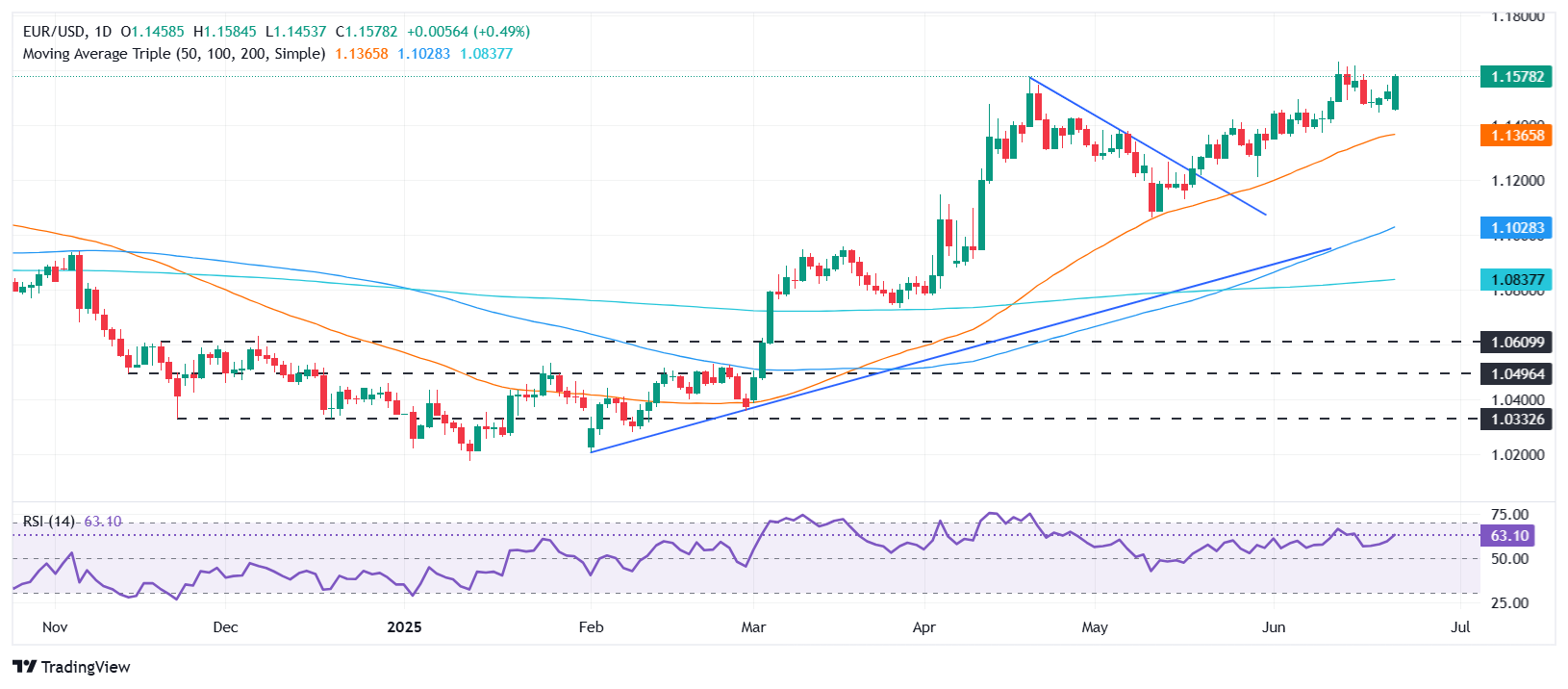EUR/USD climbs despite weak EU PMIs, Middle East conflict dominates sentiment
- Euro shrugs off poor HCOB PMIs; German data slightly improves but stays in contraction.
- Iran strikes US base in Qatar after US attacks Iranian nuclear sites; IAEA cooperation suspended.
- Traders await Powell’s testimony, German IFO data and fresh ECB commentary this week.
The Euro (EUR) advances against the US Dollar (USD) on Monday, despite the market mood remaining downbeat amid the Middle East crisis. Worse than expected HCOB Flash PMIs in the Eurozone barely weighed in the shared currency, while German PMIs showed a slight improvement, though they remained in contractionary territory. At the time of writing, EUR/USD trades at 1.1567, up 0.40%.
Geopolitics are the primary driver on Monday, as we head into the latest trading week in June. Last Saturday, the US delivered an attack on the three most critical nuclear facilities in Iran, following failed efforts by the White House to reach a deal with Tehran.
Consequently, Iran delivered strikes on a US base in Qatar. Regarding the Ain al-Assad base in Iraq, sirens were activated, as preparation for an expected attack, but there were no missiles launched. Alongside military action, Iran’s parliament decided to suspend cooperation with the International Atomic Energy Agency (IAEA).
Data-wise, S&P Global revealed that business activity in the US expanded in the manufacturing sector. Regarding services, companies reported that they’re growing at a healthy pace, despite June numbers dipping compared to the previous month’s print.
Across the pond, Eurozone HCOB Flash PMIs deteriorated further, missing estimates. In Germany, Flash PMIs improved, providing some relief on the shared currency, even though the European Central Bank (ECB) President Christine Lagarde mentioned that “survey data point overall to some weaker prospects for economic activity in the near-term.”
Now, EUR/USD traders' attention shifts to Federal Reserve (Fed) Chair Jerome Powell's testimony before the US Congress and Fed speakers. In the Eurozone, the docket will feature the release of Germany’s IFO Business Climate for June, and speeches by ECB De Guindos and ECB Chief Economist Philip Lane.
Daily digest market movers: EUR/USD boosted by Fed’s dovish tilt
- EUR/USD extended a leg up after Fed Governor Michelle Bowman shifted dovish and said that she’s open to reducing interest rates at the July Federal Open Market Committee (FOMC) meeting, if inflation pressures remained contained.
- The US S&P Global Manufacturing PMI remained steady at 52 in June, surpassing expectations of 51 and indicating continued expansion in the sector. Meanwhile, the Services PMI eased to 53.1 from 53.7, though it slightly outperformed forecasts of 52.9.
- The US Dollar Index (DXY), which tracks the buck’s performance against a basket of six currencies, drops 0.42% to 98.35. US Treasury bond yields are also on the back foot, a tailwind for Gold prices.
- The Eurozone HCOB Manufacturing PMI for June was unchanged at 49.4 in contraction territory, below forecasts of 49.8. The Services PMI improved from 49.7 to 50 as projected. Germany’s HCOB Manufacturing PMI improved from 48.3 to 49 as expected, while the Services PMI improved from 47.1 to 49.4 but remained shy of expansionary territory.
- Last week, the Fed Chair Jerome Powell said they’re in wait-and-see mode, adding that policy is modestly restrictive. He added that as long as the labor market remains solid and inflation cools down, holding rates is the “right thing to do.”
- Financial market players do not expect that the ECB will reduce its Deposit Facility Rate by 25 basis points (bps) at the July monetary policy meeting.
Euro technical outlook: EUR/USD surges past 1.1550 as bulls target 1.1600
EUR/USD is upwardly biased, having gapped down and opened the week at around 1.1454, due to risk aversion. Nevertheless, as sentiment improved and Fed Governor Bowman tilted dovish, the pair reclaimed 1.1500, extending its gains past 1.1550.
The Relative Strength Index (RSI) resumed its upward path, an indication that buyers are gathering steam. That said, the EUR/USD path of least resistance is tilted to the upside. The first resistance would be the 1.1600 figure, followed by the June 12 yearly peak of 1.1631. On further strength, the pair could aim towards 1.1650 and 1.1700.
Conversely, if it tumbles below 1.1550, it paves the way for testing 1.1500. Once cleared, the next support is the 20-day Simple Moving Average (SMA) at 1.1450 ahead of 1.1400.

Euro FAQs
The Euro is the currency for the 19 European Union countries that belong to the Eurozone. It is the second most heavily traded currency in the world behind the US Dollar. In 2022, it accounted for 31% of all foreign exchange transactions, with an average daily turnover of over $2.2 trillion a day. EUR/USD is the most heavily traded currency pair in the world, accounting for an estimated 30% off all transactions, followed by EUR/JPY (4%), EUR/GBP (3%) and EUR/AUD (2%).
The European Central Bank (ECB) in Frankfurt, Germany, is the reserve bank for the Eurozone. The ECB sets interest rates and manages monetary policy. The ECB’s primary mandate is to maintain price stability, which means either controlling inflation or stimulating growth. Its primary tool is the raising or lowering of interest rates. Relatively high interest rates – or the expectation of higher rates – will usually benefit the Euro and vice versa. The ECB Governing Council makes monetary policy decisions at meetings held eight times a year. Decisions are made by heads of the Eurozone national banks and six permanent members, including the President of the ECB, Christine Lagarde.
Eurozone inflation data, measured by the Harmonized Index of Consumer Prices (HICP), is an important econometric for the Euro. If inflation rises more than expected, especially if above the ECB’s 2% target, it obliges the ECB to raise interest rates to bring it back under control. Relatively high interest rates compared to its counterparts will usually benefit the Euro, as it makes the region more attractive as a place for global investors to park their money.
Data releases gauge the health of the economy and can impact on the Euro. Indicators such as GDP, Manufacturing and Services PMIs, employment, and consumer sentiment surveys can all influence the direction of the single currency. A strong economy is good for the Euro. Not only does it attract more foreign investment but it may encourage the ECB to put up interest rates, which will directly strengthen the Euro. Otherwise, if economic data is weak, the Euro is likely to fall. Economic data for the four largest economies in the euro area (Germany, France, Italy and Spain) are especially significant, as they account for 75% of the Eurozone’s economy.
Another significant data release for the Euro is the Trade Balance. This indicator measures the difference between what a country earns from its exports and what it spends on imports over a given period. If a country produces highly sought after exports then its currency will gain in value purely from the extra demand created from foreign buyers seeking to purchase these goods. Therefore, a positive net Trade Balance strengthens a currency and vice versa for a negative balance.

